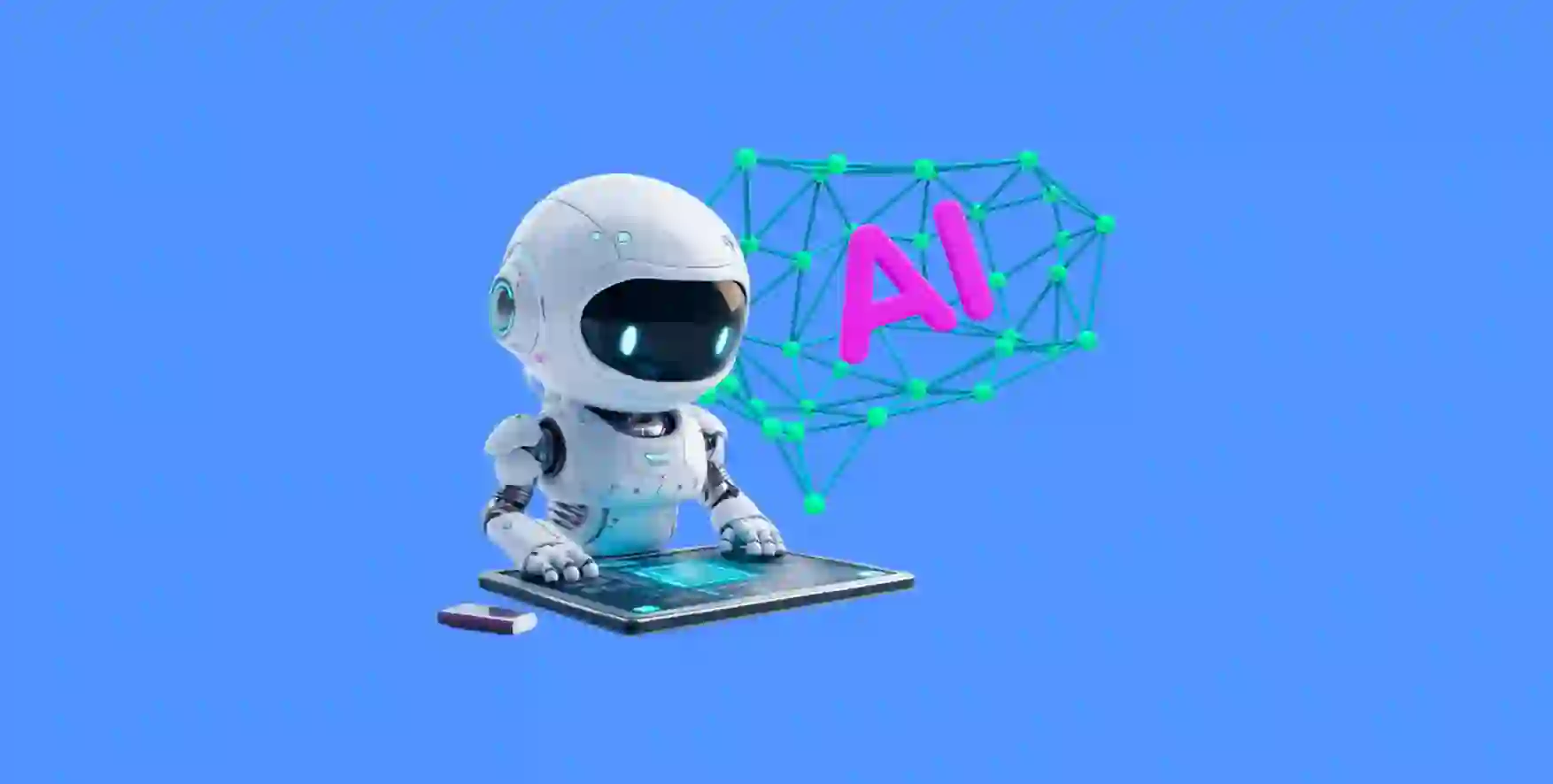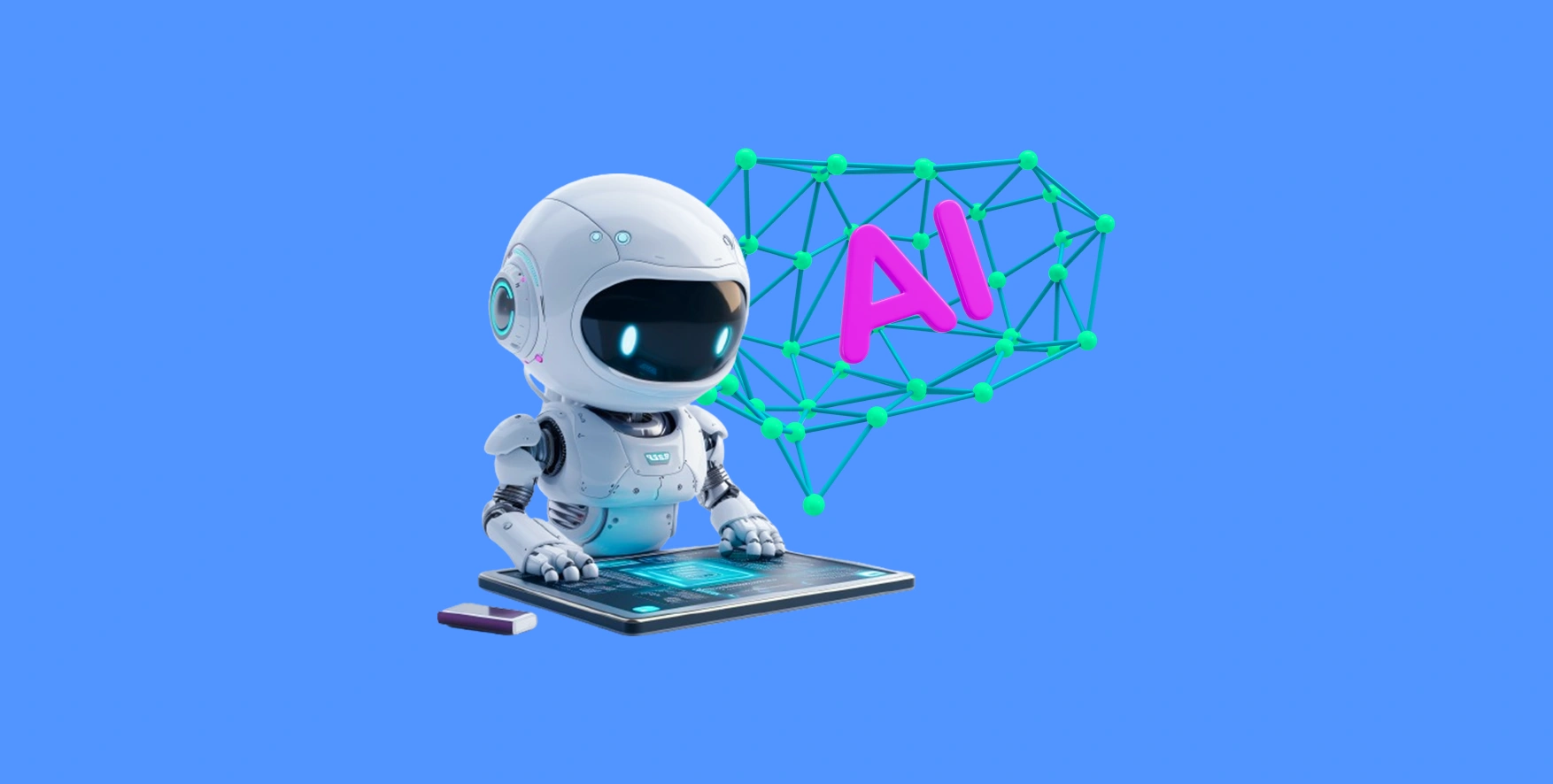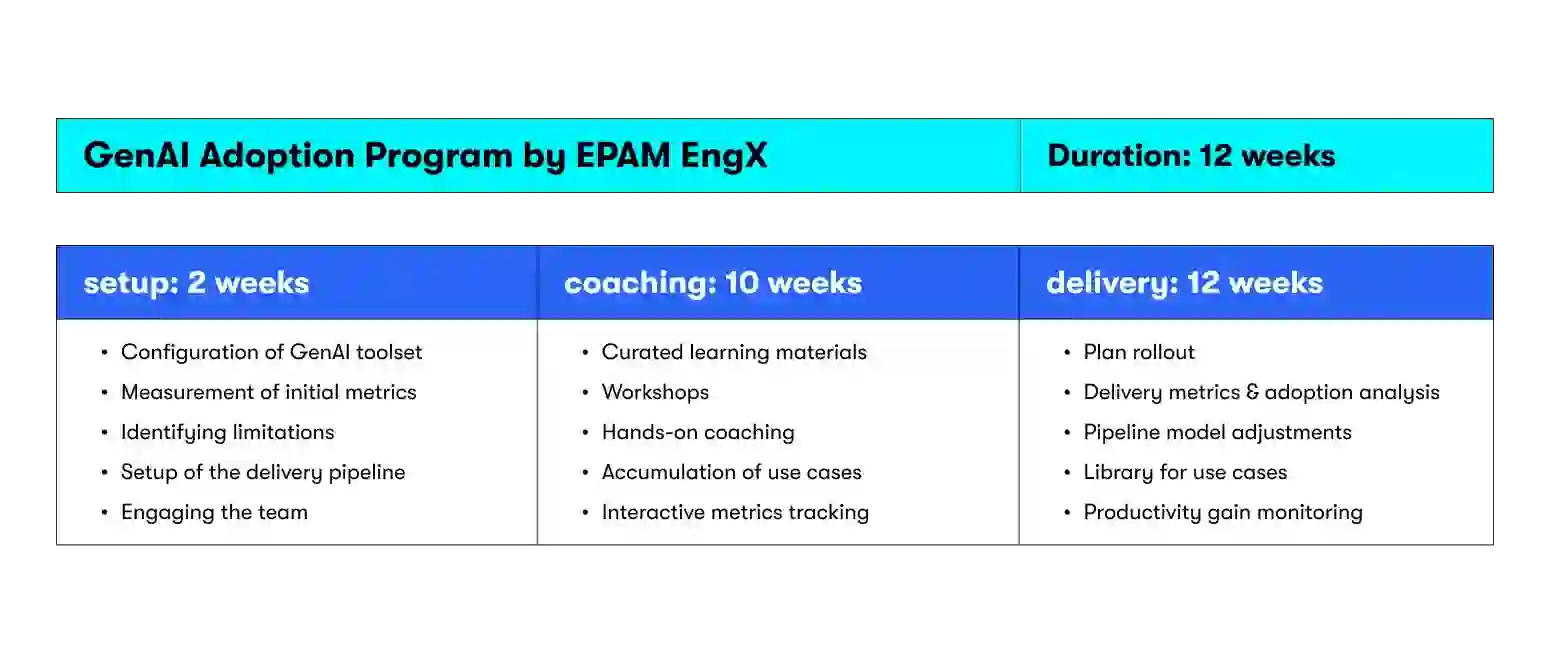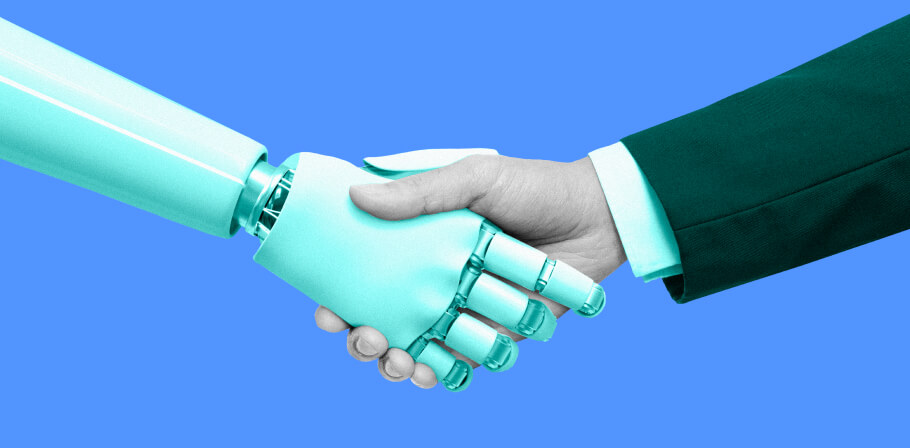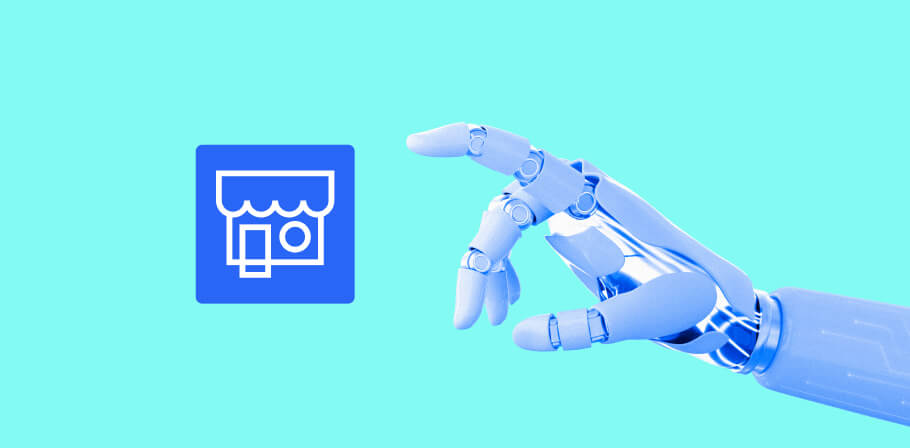Artificial intelligence (AI) has been transforming numerous industries globally, and software engineering is no exception. Integrating AI and software engineering is a key breakthrough in this domain, offering tremendous potential to augment software development processes.
Business owners and decision-makers must understand the value of GenAI and how it can be leveraged to enhance their software delivery. By adopting the GenAI-assisted engineering framework by EPAM EngX, you can kickstart the generative AI transformation of your software delivery processes and stay ahead in the competitive market.
Learn about the key generative AI applications, gains and implementation advice for business leaders below, with commentary by EPAM’s sdlc.ai Initiative Lead, Maxim Saplin.
How is generative AI changing software development?
Generative AI is an advanced technology that automates the creation of high-quality impactful content. AI-powered tools can automate software development tasks, improve developer productivity, assist in bug detection and fixing, and help create more intelligent, user-centric applications. In software development, GenAI can assist developers to write code, minimize coding errors, generate documentation, automate testing, and even design software architecture. This not only saves time and reduces costs but also enhances the quality and efficiency of the software development process. While the fear of AI replacing human software engineers is prevalent, the true essence of the foreseeable future lies in AI assisting and augmenting human capabilities rather than replacing them.
“At the moment, GenAI in software development provides marginal improvements at the system level. The tools are still contained and can't replace professional developers, serving mainly as an ergonomic factor.”

What are top GenAI use cases in software engineering?
Generative AI is a powerful tool that can potentially revolutionize the field of software engineering. Its ability to generate new content, process and summarize data, facilitate semantic search, power engineering processes, and support conversational and analytical tasks makes it an invaluable asset. While there is ongoing debate about whether AI will replace software engineers, the consensus is that AI will augment rather than replace human capabilities, allowing engineers to focus on more complex and creative tasks.
Let’s delve into use cases of GenAI in more detail:
Code generation
Generative AI has significantly transformed the realm of content generation. This primarily refers to automated code generation in the software engineering landscape. Although this may sound futuristic, it’s already becoming a reality.
“Of all GenAI use cases, AI coding assistants and general chatbots are the few that work fine. Other applications might not be as valuable as of now.”

GenAI can analyze existing codebases, understand the underlying coding patterns, and generate new code aligning with these patterns. This process is efficient and ensures a high degree of consistency in the code, reducing the possibility of human errors that could lead to bugs or system failures.
However, involving human staff in code reviews is crucial to ensure the quality and reliability of AI-generated code.
Data processing & summarization
Software development often involves dealing with vast volumes of data, including users, systems, performance, and more. Processing and making sense of this data manually can be daunting. This is where GenAI comes into play. It can automate data processing and summarization, turning raw data into actionable insights. For instance, GenAI can analyze log files to identify patterns, anomalies, or potential issues, summarize the findings, and present them in an easily digestible format.
Semantic search
Semantic search is another powerful application of GenAI in software engineering. Traditional keyword-based search methods can be time-consuming and fail to deliver the desired results. Semantic search, on the other hand, leverages AI to understand the intent and context of a search query, delivering more accurate and relevant results. This can be particularly useful for software developers looking for specific pieces of code, bug reports, or documentation.
AI-powered engineering
AI-powered engineering is a broad term encompassing various AI applications in the engineering process. This could include automated software architecture design, predictive debugging, performance optimization, and more. For instance, GenAI can analyze a software system's requirements and automatically generate a suitable architecture design. This speeds up the design process and ensures a robust and efficient architecture that aligns with the system's requirements.
Conversational & analytics
Conversational AI and analytics are two other significant applications of GenAI in software engineering. Natural language processing, including machine and deep learning models such as text preprocessing, sentiment analysis, and named entity recognition, is essential for these applications. Conversational AI refers to AI-powered chatbots or virtual assistants seamlessly using natural language to interact with users. These chatbots can provide 24/7 support to software engineers, answering their queries, guiding them through complex tasks, and even helping them debug issues.
ADOPT GENAI FOR SOFTWARE ENGINEERING IN 12 WEEKS
Enroll in our EngX GenAI Adoption Program and see your team’s productivity soar by up to 40%.
Key gains of using AI in software development
The integration of AI in your software development lifecycle can yield numerous benefits. AI can transform your software development processes from enhancing productivity to driving innovation. Here are some of the key gains of using GenAI in software development, whether in-house or through outsourced services:
Increased productivity
AI can automate mundane and repetitive tasks, such as coding and testing, which traditionally required significant human effort, and thus allow engineers to focus on more complex and innovative work. Tools like Visual Studio Code offer real-time code completion, automated code analysis, and security vulnerability detection, further enhancing productivity. This automation allows your software development team to focus on more complex tasks and problem-solving activities, increasing your developers' productivity with AI support.
Enhanced quality
AI algorithms are designed to identify and rectify errors with high accuracy. They can detect anomalies, inconsistencies, and potential issues that might be overlooked by human developers. This leads to higher quality software, as AI can aid in thorough testing and debugging, reducing the chances of errors or defects in the final product.
Reduced costs
AI's increased efficiency and productivity in software development processes can significantly reduce costs. By automating routine tasks, AI reduces the time and human resources required, leading to cost savings. AI's advanced error detection capabilities can also prevent costly mistakes and rework, providing further savings.
Faster delivery
AI's predictive capabilities and automation can expedite the software delivery process. AI tools can predict potential issues and bottlenecks, enabling proactive measures to mitigate them. Moreover, with the automation of tasks like coding and testing, the time taken to deliver a software product from inception to market is significantly reduced.
Scalability
GenAI can easily handle large volumes of data and tasks, providing scalability to your software development processes. As your business grows, GenAI tools can adapt and scale up to meet the increasing demands without compromising quality or efficiency. This makes AI a valuable asset for businesses looking to expand and grow.
Innovation
By automating routine tasks, GenAI frees up your team's time, allowing them to focus on more innovative and complex aspects of software development. This fosters creativity and innovation, as your team can explore new ideas, technologies, and solutions. In this way, GenAI enhances the efficiency of software development and drives innovation and progress.
MAXIMIZE YOUR ROI WITH GENAI ADOPTION
Explore how genAI can deliver significant returns on investment by enhancing productivity, reducing costs, and improving software quality.
GenAI implementation challenges, risks & limitations
While generative AI offers immense potential for enhancing software development processes, it's essential to understand that implementing this technology also comes with challenges, risks, and limitations.
“Reliability, cost, autonomy, and growing the scope of tasks are among the key challenges to be addressed before GenAI can become mainstream for business adopters. Now large language models (LLMs) are good with small self-contained tasks and are challenged by anything real-world (bigger, complicated, with external dependencies, etc.)”

Let's delve into some of these challenges in detail:
Added complexity and maintenance challenge
Incorporating GenAI into software development processes adds a layer of complexity to the system. While AI can automate many tasks, AI systems require regular maintenance and updates to function optimally. This includes:
- Updating the AI algorithms to ensure they align with the latest advancements and best practices.
- Retraining the language models with new data to improve their accuracy and performance.
- Troubleshooting any issues can be challenging, given the complex nature of AI systems.
AI systems require significant human oversight and maintenance, ensuring that engineers remain an essential part of the development process.
These activities require a high level of expertise and can be time-consuming, adding to the overall complexity of the software development process.
Data dependency
AI systems, including GenAI, are heavily dependent on data. They require large volumes of high-quality data for training and functioning. However, collecting, cleaning, and managing such data can be challenging. The performance and accuracy of GenAI systems are directly influenced by the quality of the data on which they are trained. If the training data is not balanced or complete, the AI system may produce inaccurate or biased results, impacting the software quality. Data privacy and security are other challenges, as AI systems often handle sensitive data. Therefore, organizations must invest in robust data analysis and management practices to leverage GenAI effectively.
Ethical concerns
The use of AI in software development also raises several ethical concerns. These include issues related to privacy, security, and bias. For instance, if an AI system is trained on biased data, it may produce biased outcomes, leading to unfair practices. Similarly, AI systems that handle sensitive data must have robust security measures to prevent breaches. These ethical concerns must be addressed proactively to ensure the responsible use of AI in software development. This calls for developing and enforcing ethical guidelines and policies related to AI use.
High initial investment
The implementation of GenAI in software development requires a high initial investment. This includes the cost of acquiring or developing the AI technology, integrating it into the existing systems, and training the staff to work with the new technology. While this investment can yield significant returns in the long run, it can be a barrier for small and medium-sized businesses with limited resources. Therefore, organizations must carefully evaluate the potential return on investment before implementing GenAI in their software development processes. This may involve conducting feasibility studies and cost-benefit analyses to make informed decisions.
Lack of explainability
One of the inherent limitations of AI systems, including GenAI, is their need for explainability and transparency.
Often, AI systems make decisions or predictions based on complex algorithms and large amounts of data, making it difficult for humans to understand or explain their reasoning. This lack of transparency can be a significant challenge, especially in scenarios where it's crucial to understand how the AI system arrived at a particular decision or prediction.
As such, organizations need to invest in explainable AI technologies and practices to ensure transparency and trust in their AI systems.
Dependence on high-quality infrastructure
The successful implementation and operation of GenAI in software development requires a high-quality infrastructure. This includes state-of-the-art hardware to support the computational demands of AI systems and reliable, high-speed internet to facilitate data transfer and real-time operations. However, setting up and maintaining such an infrastructure can take time and effort. Moreover, any downtime or performance issues with the infrastructure can directly impact the performance of the AI systems, leading to delays or disruptions in the software development process. Therefore, organizations must ensure they have the necessary infrastructure and plan for regular maintenance and upgrades to support their GenAI initiatives effectively.
LEVERAGE THE POWER OF GENAI SAFELY WITH EPAM ENGX
Harness the power of generative AI in your software development processes safely with our expertly designed genAI-assisted engineering framework.
How much can companies save using AI for software engineering?
The integration of AI into software development, particularly generative AI, can lead to considerable cost savings for companies. While the exact savings can vary depending on various factors, the potential for cost reduction is substantial.
AI can reduce costs by automating routine tasks such as coding, testing, and debugging. These tasks, which would otherwise require significant human effort and time, can be performed more efficiently by AI, reducing labor costs. Moreover, by automating these tasks, companies can reallocate their human resources to more strategic, high-value tasks, optimizing resource utilization and enhancing productivity.
How to measure the impact of generative AI in software engineering?
Measuring the impact of GenAI adoption in software development involves assessing various quantitative and qualitative metrics. These may include:
- Productivity metrics: Measure the increase in output or the reduction in time taken for tasks automated by AI.
- Quality metrics: Assess the reduced errors or defects in the software, indicating improved quality due to AI.
- Cost metrics: Calculate the cost savings achieved through AI, considering factors like reduced labor costs, lower rework costs, and savings from faster time-to-market.
- Innovation metrics: Evaluate the new features or capabilities enabled by AI, indicating its impact on innovation.
How to use GenAI in your SDLC: advice for tech leaders
Implementing AI in your software development life cycle (SDLC) can be transformative. However, it requires careful planning and execution. Here are some steps leaders can follow:
Step 1: Understand the potential of AI
The first step is understanding AI's potential and how it can enhance software development processes. This involves learning about different AI technologies, including GenAI and machine learning, and their applications in frontend and backend software development. Leaders should invest time and resources in researching the latest AI trends, understanding their implications, and identifying how they can be leveraged to enhance their software development.
“Connect the strategic calls for GenAI adoption with real-life use cases. Hype, FOMO and following the rest of the pack are primal instincts that seem to be driving the hysteria. Hence there's little connection between actual implementation and all of those "AI-first" motos.”

Step 2: Identify opportunities for AI integration
Once you understand AI well, the next step is identifying areas in your SDLC where AI can be integrated. This could be anywhere from automating coding tasks to enhancing software testing, improving project management, or facilitating predictive analytics. Leaders should work closely with their software development teams to identify these opportunities and develop a strategic plan for integrated development environments. While identifying these opportunities, it is important to consider that AI will not replace software engineers but augment their capabilities, allowing them to focus on more strategic and high-value tasks.
Step 3: Build or acquire the necessary AI technology
Depending on your needs and resources, you can build your AI technology or acquire it from a reliable vendor. Leaders should carefully evaluate different AI technologies, considering their capabilities, cost, ease of integration, and support services. They should also ensure that the chosen AI technology aligns with their software development needs and can integrate seamlessly with their existing systems.
Step 4: Train your team
Implementing AI technology is not just about the technology itself but also about the people using it. Therefore, training your team to work with the new AI technology is crucial. This includes technical training on using AI tools and conceptual training on understanding AI and its implications. Leaders should plan for this training and ensure their team has the necessary skills and knowledge to leverage AI effectively.
Step 5: Monitor and optimize
Finally, once AI is implemented, monitoring its performance and impact on software development processes is important. These insights allow you to optimize code with AI in a transparent and measurable way. Further on, improve processes to maximize the attained benefits. This could involve fine-tuning the AI algorithms, retraining the AI models with new data, or adjusting the AI integration strategy.
How can EPAM’s EngX GenAI Adoption Program help you?
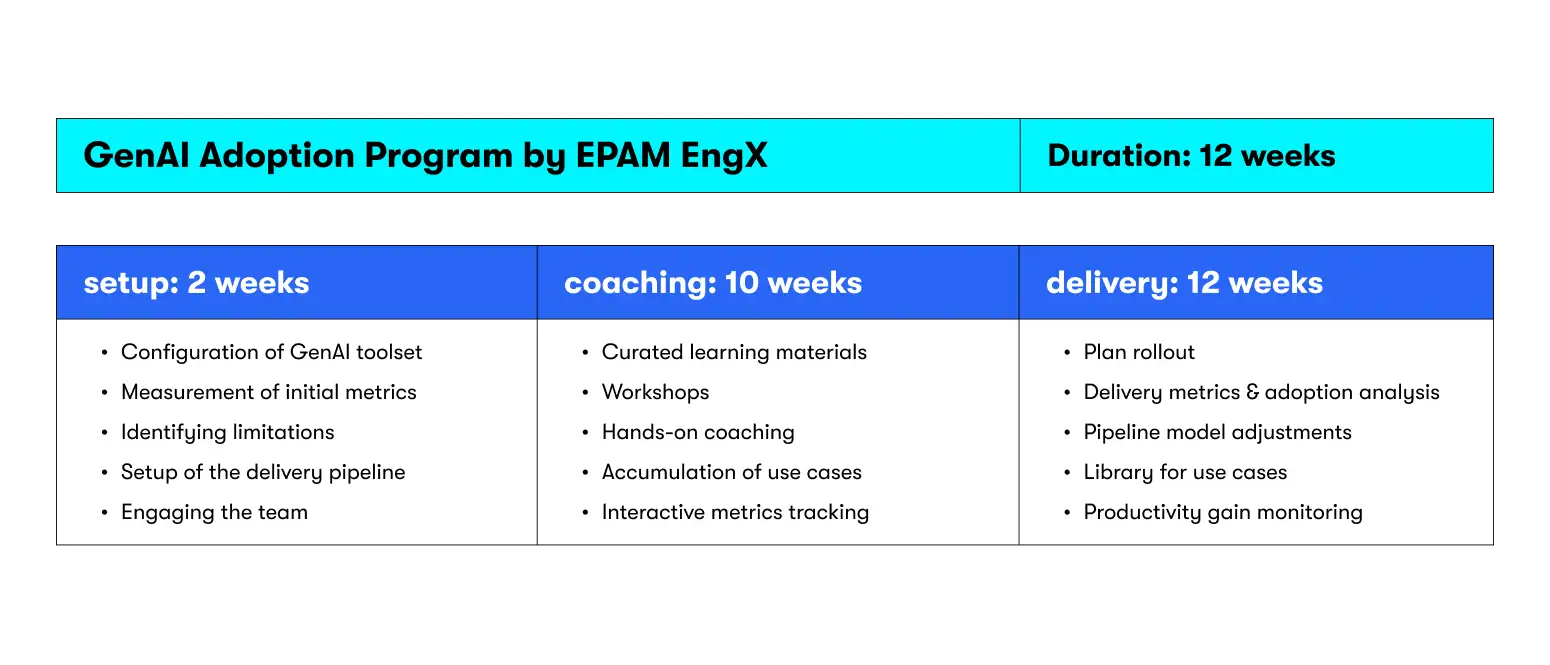
The GenAI Adoption Program by EPAM EngX is designed to help businesses leverage the power of generative AI in their software development processes. It provides a structured and systematic approach to GenAI adoption, ensuring businesses can effectively integrate GenAI into their operations and reap its many benefits. Here are some key value propositions of the program:
- Customized GenAI solutions: The program offers customized GenAI solutions tailored to your business's needs and requirements. This ensures that the GenAI technology aligns perfectly with your software development processes and business goals.
- End-to-end support: From initial consultation to implementation and beyond, the program provides end-to-end support to ensure successful GenAI adoption. This includes technical support, training, and ongoing maintenance and optimization services.
- Expertise: With EPAM’s extensive expertise in data science and experience in AI and software development, you can be assured of high-quality, reliable GenAI solutions. EPAM's team of experts will guide you through the process, helping you overcome challenges and maximize the benefits of GenAI.
- Innovation and efficiency: The program can help you innovate and enhance efficiency in your software development processes. By automating routine tasks, improving error detection, using machine learning models, and facilitating analytics, GenAI can transform your software development operations, leading to improved productivity, quality, and speed.
- Risk mitigation: The program also focuses on risk mitigation, ensuring that ethical considerations and potential risks associated with AI are addressed proactively. This includes measures to ensure data privacy and security and strategies to prevent and manage potential biases in AI systems.
- Long-term playbook: This comprehensive guide is part of EPAM’s EngX GenAI Adoption Program and is designed to help businesses plan and execute their GenAI adoption strategy effectively. This playbook provides a roadmap for GenAI integration, detailing the steps and actions required at each process stage. It covers aspects like identifying opportunities for AI integration, choosing the right AI technology, training the team, and monitoring and optimizing the AI systems.
- ROI assessment: This is a crucial component of EPAM’s EngX GenAI Adoption Program, which helps businesses evaluate the potential return on investment of their GenAI initiatives. It involves a detailed analysis of the costs and returns associated with GenAI adoption, including AI technology adoption, integration, and training.
Conclusion
Integrating AI, particularly generative AI, in software development holds immense potential. From automating routine tasks to enhancing software quality, speeding up delivery times, and driving innovation, the benefits of AI in software development are substantial. However, successful AI integration requires careful planning, strategic execution, and ongoing monitoring and optimization. With the right approach and resources, businesses can effectively leverage AI in their software development processes and achieve significant efficiency, quality, and innovation gains.
FAQ

Expert digital communicator and editor providing insights and research-based guides for technology buyers globally.
Expert digital communicator and editor providing insights and research-based guides for technology buyers globally.

Explore our Editorial Policy to learn more about our standards for content creation.
read more